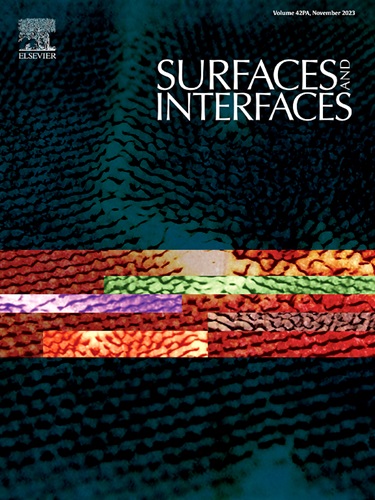为太阳能电池开发具有光催化和疏水自清洁性能的抗反射涂层
IF 5.7
2区 材料科学
Q2 CHEMISTRY, PHYSICAL
引用次数: 0
摘要
光伏组件表面积聚的灰尘和污垢会大大降低发电效率,这是一个巨大的挑战。为了解决这一限制,我们设计了一种集抗反射和自清洁特性于一体的多功能薄膜。这种创新薄膜是通过在玻璃基板上施加两层功能层来制造的。底层是用亲水性二氧化硅(SiO2)凝胶制成的,其中加入二氧化钛(TiO2)纳米粒子偶联氮化钨(WN)纳米粒子(表示为TiO2@WN)作为有效的光催化成分。顶层由疏水性二甲基硅油(PDMS)改性组成。优化后的SiO₂/WN@TiO₂/PDMS (SOTWH)涂层的平均透过率(92.83%)比裸玻璃(90.67%)提高了2.16%,其机械坚固性(维氏硬度为437.08 N/mm²)得到了证明。SOTWH膜在120 min内对盐酸四环素的去除率为66%,对罗丹明B的去除率为48%。协同表面工程使SOTWH膜具有104.5°的水接触角,能够通过雨水驱动的剪切力有效去除污染物。这种双模式自清洁机制结合了光催化分解和疏水除尘器,优于商用防污涂料。开发的薄膜系统提供了一种技术上可行的解决方案,通过光学活性,耐用和环境响应的表面工程来维持光伏性能。本文章由计算机程序翻译,如有差异,请以英文原文为准。

Development of anti-reflective coatings with photocatalytic and hydrophobic self-cleaning property for solar cells
Accumulation of dust and dirt on the surfaces of photovoltaic modules significantly diminishes power generation efficiency, posing a formidable challenge. To address this limitation, we engineered a multifunctional film integrating anti-reflective and self-cleaning properties. The innovative film was fabricated by applying two functional layers on a glass-substrate. The bottom layer was created using a hydrophilic silicon dioxide (SiO2) based gel, into which titanium dioxide (TiO2) nanoparticles coupled tungsten nitride (WN) nanoparticles (denoted as TiO2@WN) were added as an effective photocatalytic component. The top layer consisted of a hydrophobic dimethyl silicone oil (PDMS) modification. The optimized SiO₂/WN@TiO₂/PDMS (SOTWH) coating demonstrated a 2.16 % increase in average transmittance (92.83 %) compared to bare glass (90.67 %), and its mechanical robustness was evidenced by a Vickers hardness of 437.08 N/mm². The SOTWH film also exhibited superior photocatalytic degradation efficiencies of 66 % tetracycline hydrochloride and 48 % rhodamine B removal within 120 min, respectively. Synergistic surface engineering endowed the SOTWH film with a water contact angle of 104.5°, enabling efficient contaminant removal through rain-driven shear forces. This dual-mode self-cleaning mechanism combined photocatalytic decomposition and hydrophobic dust repulsion, outperforming the commercial anti-soiling coatings. The developed film system presents a technologically viable solution for sustaining photovoltaic performance through optically active, durable, and environmentally responsive surface engineering.
求助全文
通过发布文献求助,成功后即可免费获取论文全文。
去求助
来源期刊

Surfaces and Interfaces
Chemistry-General Chemistry
CiteScore
8.50
自引率
6.50%
发文量
753
审稿时长
35 days
期刊介绍:
The aim of the journal is to provide a respectful outlet for ''sound science'' papers in all research areas on surfaces and interfaces. We define sound science papers as papers that describe new and well-executed research, but that do not necessarily provide brand new insights or are merely a description of research results.
Surfaces and Interfaces publishes research papers in all fields of surface science which may not always find the right home on first submission to our Elsevier sister journals (Applied Surface, Surface and Coatings Technology, Thin Solid Films)
 求助内容:
求助内容: 应助结果提醒方式:
应助结果提醒方式:


